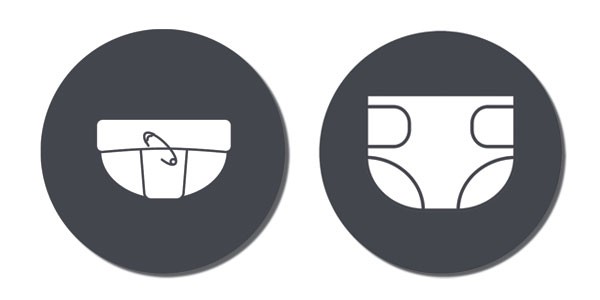The Great Diaper Debate: Reusable or Disposable Which one is better for the environment?
by BusinessWoman magazine / 0 Comments / 590 View / April 1, 2016
With lots of attention keyed on “going green,” consumers are choosing hybrid cars, bringing reusable bags to the grocery store, and recycling everything from soda cans to coffee containers. This ongoing concern for the environment leaves new parents struggling with the choice between cloth and disposable diapers and wondering which is better for Mother Earth.
Before a baby celebrates her first birthday, she will have had her diaper changed close to 3,000 times. On average, a baby soils nearly 10 diapers every day. That adds up to about 6,000 diapers by the time she’s potty trained.
So the decision about which kind of diaper to use for those thousands of changes is a big one. For most parents, it comes down to a choice between convenience and minimizing the effects soiled diapers have on the environment.
Disposables Are Gone, But Not Forgotten
Every year, nearly 20 billion disposable diapers are dumped in landfills throughout the United States, according to the Environmental Protection Agency. The additional 3.5 million tons of waste from disposables can take decades to decompose, leaving behind traces of dioxin from the paper-bleaching process, according to the Real Diaper Association.
Some manufacturers address this concern by producing eco-friendly disposable diapers containing biodegradable materials. But because trash in landfills lacks exposure to air and sun, the waste is impeded from decaying naturally.
Loads of Laundry
Proponents of disposables often contrast the number of diapers that end up in landfills with the environmental concession of washing cloth diapers. As resources become strained, the water and energy required to wash and dry cloth diapers exacts a toll.
Laundering diapers requires energy and water and the detergents used pollute the nation’s waters. Some fans of disposables even argue that diaper-service trucks use gas and oil and add to air pollution.
Tereson Dupuy, founder of Fuzzi Bunz diapers, disagrees.
“We don’t throw away our clothes or dishes each week. We wash them,” Dupuy says. “This is the same mentality. Energy-efficient washers and air drying the diapers cuts a lot out of the energy cycle. No extra trips to the store to buy diapers over and over again. No packaging waste.”
Additionally, contaminated, dirty water from the washing machine goes into the sewer system. The water is properly treated at wastewater plants. Ecologist say that treated wastewater is much more environmentally friendly than dumping untreated, soiled disposable diapers into a landfill.
According to Consumer Reports, parents will spend between $1,500 and $2,000 on disposable diapers for their child. That’s one reason Melissa Kovacs felt that she should use cloth diapers that she washes herself.
“I realized that another load of laundry—one that’s easily folded the same way and put back in one spot every other day or so—wouldn’t wreak much havoc on my laundry life,” said Kovacs, mother of 9-month-old Emily, 3-year-old Luke, 6-year-old Kate, and 8-year-old Anna. “It’s harder to get my preschooler to stop changing clothes every time the mood suits him.
“I wish I had invested in the diaper wraps and cloth diapers earlier,” she adds. “I would have benefited from the investment at the beginning of diapering days.”
What’s Good For Baby’s Bottom
Convenience and cleanliness in the nursery are the two top reasons parents chose disposable diapers over reusable ones. Disposables have an advantage because babies stay dry longer due to the modern materials that keep moisture away from baby’s bottom.
Disposables have a sponge-like pad that contains chemical crystals designed to absorb up to 800 times their weight in liquid and hold it in gel form. The result is fewer incidents of diaper rash. Of course, changing (cloth or disposable) diapers frequently is the easiest, most reliable way to reduce diaper rash.
If you wash cloth diapers at home, the American Academy of Family Physicians suggests boiling them for 15 minutes on the stove after washing. This will kill germs and remove soap residue that could irritate your baby’s skin.
Like many debates, the real impact of disposable and cloth diapers on the environment is unclear. Reusable vs. disposable—either choice has its advantages and disadvantages for you, baby, and the environment.
The decision on which to use will be dictated by what aspects of the environment you value most. If you decide that you can’t live without disposable diapers, perhaps you can find other ways to go green and do your part to be eco-friendly.
They’d Rather Fight Than Switch
A survey conducted by the Rechargeable Battery Recycling Corporation (RBRC) probed why consumers do (or don’t) recycle and what would (or wouldn’t) make them alter their behavior to be more environmentally conscious.
The survey reported that nearly 90 percent of Americans are recycling at least one item. Respondents were asked what the one “green” thing was they can’t see themselves doing. Not surprisingly, for parents with children under age 6, the answer was switching from disposable diapers to cloth diapers. BW
Claire Yezbak Fadden is an award-winning freelance writer and mother of three sons. Follow her on Twitter @claireflaire.


Your Commment
You must be logged in to post a comment.